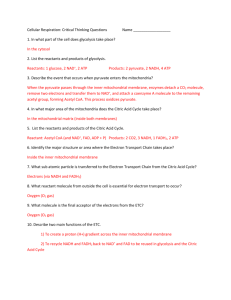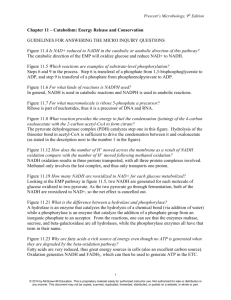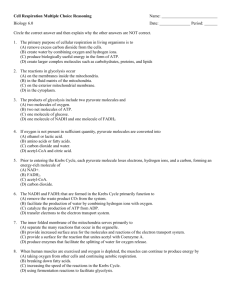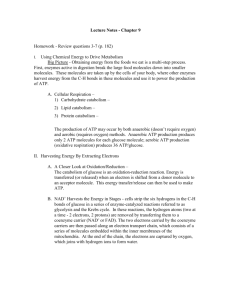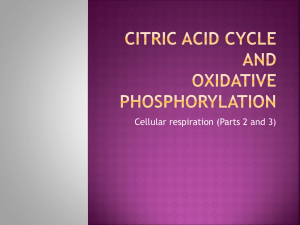Oxidation – a molecule loses electrons
advertisement
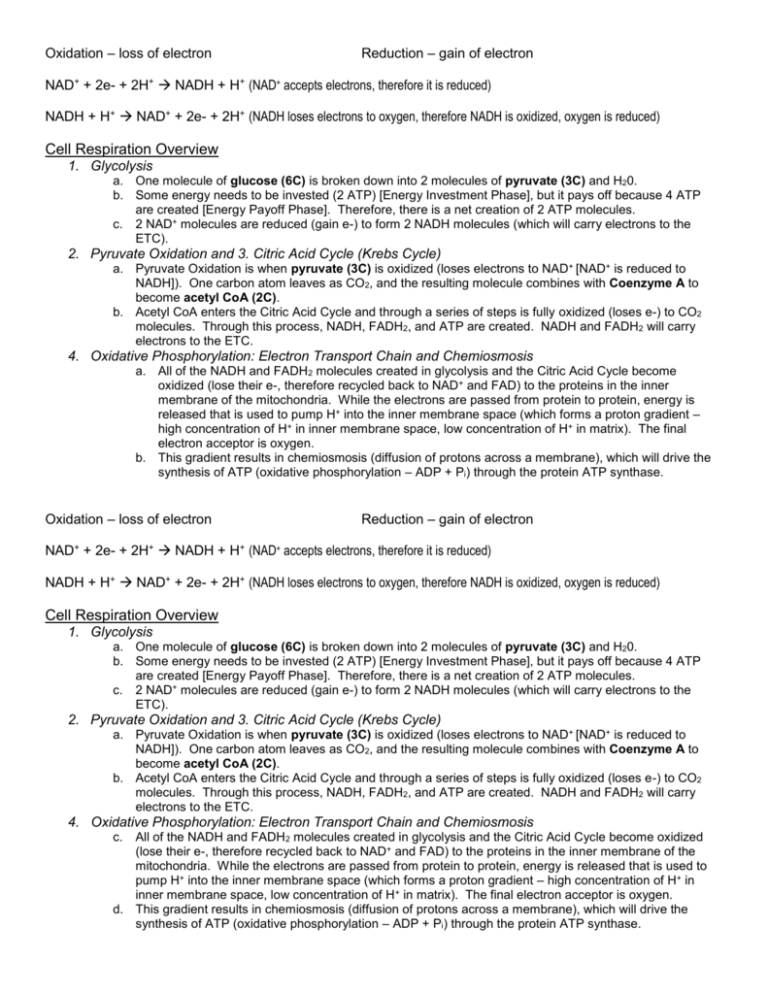
Oxidation – loss of electron Reduction – gain of electron NAD+ + 2e- + 2H+ NADH + H+ (NAD+ accepts electrons, therefore it is reduced) NADH + H+ NAD+ + 2e- + 2H+ (NADH loses electrons to oxygen, therefore NADH is oxidized, oxygen is reduced) Cell Respiration Overview 1. Glycolysis a. One molecule of glucose (6C) is broken down into 2 molecules of pyruvate (3C) and H20. b. Some energy needs to be invested (2 ATP) [Energy Investment Phase], but it pays off because 4 ATP are created [Energy Payoff Phase]. Therefore, there is a net creation of 2 ATP molecules. c. 2 NAD+ molecules are reduced (gain e-) to form 2 NADH molecules (which will carry electrons to the ETC). 2. Pyruvate Oxidation and 3. Citric Acid Cycle (Krebs Cycle) a. Pyruvate Oxidation is when pyruvate (3C) is oxidized (loses electrons to NAD+ [NAD+ is reduced to NADH]). One carbon atom leaves as CO2, and the resulting molecule combines with Coenzyme A to become acetyl CoA (2C). b. Acetyl CoA enters the Citric Acid Cycle and through a series of steps is fully oxidized (loses e-) to CO2 molecules. Through this process, NADH, FADH2, and ATP are created. NADH and FADH2 will carry electrons to the ETC. 4. Oxidative Phosphorylation: Electron Transport Chain and Chemiosmosis a. All of the NADH and FADH2 molecules created in glycolysis and the Citric Acid Cycle become oxidized (lose their e-, therefore recycled back to NAD+ and FAD) to the proteins in the inner membrane of the mitochondria. While the electrons are passed from protein to protein, energy is released that is used to pump H+ into the inner membrane space (which forms a proton gradient – high concentration of H+ in inner membrane space, low concentration of H+ in matrix). The final electron acceptor is oxygen. b. This gradient results in chemiosmosis (diffusion of protons across a membrane), which will drive the synthesis of ATP (oxidative phosphorylation – ADP + Pi) through the protein ATP synthase. Oxidation – loss of electron Reduction – gain of electron NAD+ + 2e- + 2H+ NADH + H+ (NAD+ accepts electrons, therefore it is reduced) NADH + H+ NAD+ + 2e- + 2H+ (NADH loses electrons to oxygen, therefore NADH is oxidized, oxygen is reduced) Cell Respiration Overview 1. Glycolysis a. One molecule of glucose (6C) is broken down into 2 molecules of pyruvate (3C) and H20. b. Some energy needs to be invested (2 ATP) [Energy Investment Phase], but it pays off because 4 ATP are created [Energy Payoff Phase]. Therefore, there is a net creation of 2 ATP molecules. c. 2 NAD+ molecules are reduced (gain e-) to form 2 NADH molecules (which will carry electrons to the ETC). 2. Pyruvate Oxidation and 3. Citric Acid Cycle (Krebs Cycle) a. Pyruvate Oxidation is when pyruvate (3C) is oxidized (loses electrons to NAD+ [NAD+ is reduced to NADH]). One carbon atom leaves as CO2, and the resulting molecule combines with Coenzyme A to become acetyl CoA (2C). b. Acetyl CoA enters the Citric Acid Cycle and through a series of steps is fully oxidized (loses e-) to CO2 molecules. Through this process, NADH, FADH2, and ATP are created. NADH and FADH2 will carry electrons to the ETC. 4. Oxidative Phosphorylation: Electron Transport Chain and Chemiosmosis c. All of the NADH and FADH2 molecules created in glycolysis and the Citric Acid Cycle become oxidized (lose their e-, therefore recycled back to NAD+ and FAD) to the proteins in the inner membrane of the mitochondria. While the electrons are passed from protein to protein, energy is released that is used to pump H+ into the inner membrane space (which forms a proton gradient – high concentration of H+ in inner membrane space, low concentration of H+ in matrix). The final electron acceptor is oxygen. d. This gradient results in chemiosmosis (diffusion of protons across a membrane), which will drive the synthesis of ATP (oxidative phosphorylation – ADP + Pi) through the protein ATP synthase.
